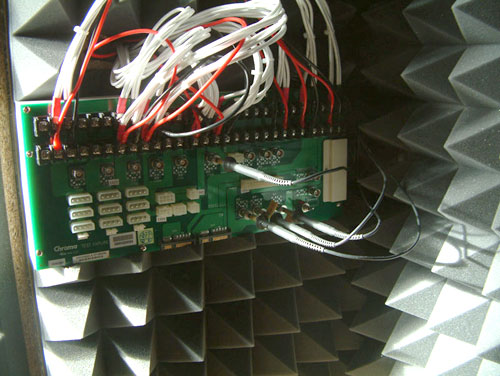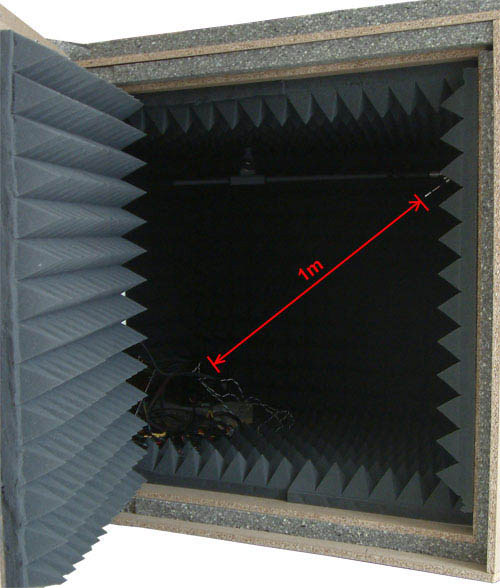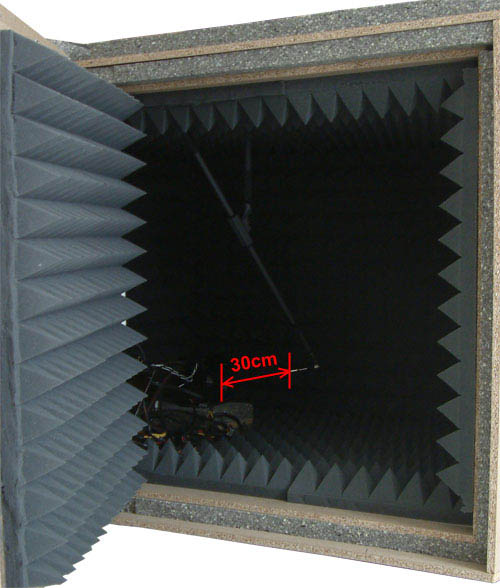AnandTech Power Supply Test Methodology
by Christoph Katzer on July 12, 2007 12:00 AM EST- Posted in
- Cases/Cooling/PSUs
The Testing Environment
There is one flaw in testing power supplies with programmable loads and while trying to test the sound pressure levels at the same time. Because the programmable loads get very loud there is no chance to even hear the power supply on the test stand. In order to make accurate measurements of the noise levels we needed a way to separate the test unit and the programmable loads. Our solution was to build a very thick box around the unit.
We concluded that a five-layer box with a total thickness of 6" (15cm) containing two layers of wood and three layers or special foam would suffice. It is designed as a box within a box. The inner box does not touch any part of the outer box, making it difficult for acoustic noise to pass through in the form of vibration. Each box is isolated on both sides with a layer of heavy foam which is normally used to isolate engines. In the inside we have an additional layer of 4" (10cm) thick pyramidal foam on every side of the box to eliminate the acoustic waves coming from the test object.

To have a completely closed system we installed the printed circuit board to which the connectors of the power supply will be attached inside the anechoic room/box. In other box designs you would need to put all the cables through the wall. Unfortunately that would result in the inside of the box not being totally isolated anymore. Our design keeps everything which needs to be connected inside of the box and maintains isolation.


The microphone hangs on a movable stand which is connected to the roof of the box. With this we can move the microphone around in the box to the position of choice. We measure each unit from two different positions. The first is from 1m distance in conformity with normal measurements. The second position is 30cm in front of the power supply at an angle where the airflow does not interfere with the actual noise measurements.
There is one flaw in testing power supplies with programmable loads and while trying to test the sound pressure levels at the same time. Because the programmable loads get very loud there is no chance to even hear the power supply on the test stand. In order to make accurate measurements of the noise levels we needed a way to separate the test unit and the programmable loads. Our solution was to build a very thick box around the unit.
We concluded that a five-layer box with a total thickness of 6" (15cm) containing two layers of wood and three layers or special foam would suffice. It is designed as a box within a box. The inner box does not touch any part of the outer box, making it difficult for acoustic noise to pass through in the form of vibration. Each box is isolated on both sides with a layer of heavy foam which is normally used to isolate engines. In the inside we have an additional layer of 4" (10cm) thick pyramidal foam on every side of the box to eliminate the acoustic waves coming from the test object.

To have a completely closed system we installed the printed circuit board to which the connectors of the power supply will be attached inside the anechoic room/box. In other box designs you would need to put all the cables through the wall. Unfortunately that would result in the inside of the box not being totally isolated anymore. Our design keeps everything which needs to be connected inside of the box and maintains isolation.


The microphone hangs on a movable stand which is connected to the roof of the box. With this we can move the microphone around in the box to the position of choice. We measure each unit from two different positions. The first is from 1m distance in conformity with normal measurements. The second position is 30cm in front of the power supply at an angle where the airflow does not interfere with the actual noise measurements.










49 Comments
View All Comments
Adul - Thursday, July 12, 2007 - link
I'd love to see a power supply catch fire :). Maybe one of the cheaper ones will break enough for this.CrystalBay - Thursday, July 12, 2007 - link
I would also like to see a short video of substandard PSU's lighting up...I'm sure many enthusiasts have had Dram's start flaming or smoke. But I have never had a PSU actually catch flame out....
Martimus - Thursday, July 12, 2007 - link
I had a Antec NeoPower PSU spew black smoke. It was not fun. Also fried my motherboard. It was less than 6 months old too, and I wasn't using it at anywhere near it's supposed capacity.BladeVenom - Thursday, July 12, 2007 - link
Then test power supplies that are in the range that most people actually need. Also test some budget ones. Let's see which ones are good for the money, and which ones are fire hazards.
xsilver - Thursday, July 12, 2007 - link
what is meant is that the idea of having a psu is NOT to load it to 100% capacity.and the problem being that it is very difficult to get a stable and repeatable psu testing setup.
I highly recommend that industrial manufacturers be pointed out just like in xbit labs reviews. That way we will know that antec has 3 or more suppliers providing psu's and be able to tell the seasonics from the other crud ;)
Wesleyrpg - Thursday, July 12, 2007 - link
hmm i wonder if thats why some people rave about Antec and some people like me curse them! I'd have to say Antec have the worst failure rate by far, probably at about 75% in the first year, where i can buy a $22 550W Generic (Honli) and only have about a 25% failure rate, maybe thats related to the power supplys released into australia by antec.imaheadcase - Thursday, July 12, 2007 - link
I kid! :Pgersson - Thursday, July 12, 2007 - link
just a red 'X'gersson - Thursday, July 12, 2007 - link
nevermind -- working already :-)